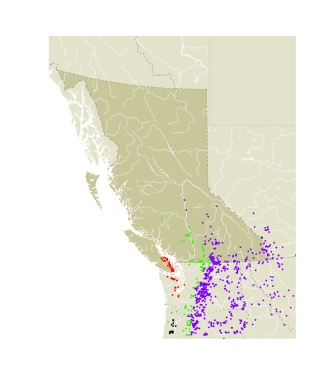AdultBoisduval's Blue is difficult to characterize. The blue on the upperside of the male wing is not clear but somewhat washed out. The male underside is brown, heavily overlaid with white scales that give it the appearance of the underside of the Sooty Hairstreak, which is not blue on the upperside. The female upperside is brown, with usually a flush of blue scales at the base of the forewing. The ground colour of the female underside is brown. For Vancouver Island individuals, the female ventral hindwing has a median row of white spots. For mainland populations, these spots are large with small black centres. The ventral forewing of Vancouver Island females has a median row of black spots surrounded by white scales. These spots are much larger in mainland populations.
Immature StagesComstock and Dammers (1935) described the egg as green overlaid by the white papillae of the chorion. The mature larva is green with three inconspicuous diagonal white lines laterally on each body segment. The body is covered with short white hairs. The pupa is green on the head, thorax, and wings, and chestnut red with green spots on the abdomen.
SubspeciesVancouver Island populations are the subspecies I.i. blackmorei (Barnes & McDunnough, 1919) (TL: Goldstream, BC). Populations from the southern Coast Range and the adjacent Cascades are I.i. montis (Blackmore, 1923) (TL: Mt. McLean, near Lillooet, BC). Populations from the Okanagan Valley eastward are the Rocky Mountain subspecies, I.i. pembina (W.H. Edwards, 1862) (TL: Ravilli Co., MT).
